Sri Lanka is a paradise for history enthusiasts and culture seekers, boasting a myriad of captivating archaeological sites that enthrall tourists. One of the most iconic destinations is the ancient city of Sigiriya, a UNESCO World Heritage Site. Towering majestically over the surrounding plains, the rock fortress of Sigiriya is a marvel of engineering and artistry. Visitors can climb the steep steps to reach the summit, where they are greeted by stunning frescoes depicting heavenly maidens. The panoramic views from the top offer a breathtaking panorama of the lush landscapes below.
Another must-visit site is the sacred city of Anuradhapura, which served as the capital of ancient Sri Lanka for over a thousand years. This sprawling archaeological complex features awe-inspiring stupas, monastic ruins, and ancient temples. The sacred Bodhi Tree, believed to be the oldest recorded tree in the world, is a significant pilgrimage site for Buddhists. Exploring the ancient ruins of Anuradhapura is like stepping back in time, as visitors are immersed in the grandeur and spirituality of Sri Lanka’s rich cultural heritage.
Dambulla Cave Temples, nestled within a massive granite outcrop, are another remarkable archaeological site not to be missed. Housing a stunning collection of cave temples adorned with intricate murals and over 150 Buddha statues, the site offers a glimpse into Sri Lanka’s religious and artistic traditions. The cave complex provides a serene and meditative atmosphere, with golden statues glimmering in the soft light that filters through the cracks of the rocky ceiling.
The historical city of Polonnaruwa is also a UNESCO World Heritage Site and showcases the remnants of a once-thriving ancient civilization. Here, visitors can explore well-preserved ruins, including the impressive Royal Palace, ancient temples, and towering statues of Lord Buddha. These archaeological sites in Sri Lanka provide an immersive and awe-inspiring journey into the country’s rich past, allowing tourists to connect with its vibrant history and cultural legacy.
Table of Contents
- Anuradhapura
- Polonnaruwa
- Kurunagala
- Kandy
- Mathale
- Badulla
- Kalutara
- Jaffana
- Trincomalee
- Ratnapura
- Colombo
- Gampaha
- Hambantota
Anuradhapura
Anuradhapura, a UNESCO World Heritage Site in Sri Lanka, holds immense archaeological importance and stands as a captivating tourist attraction. As one of the oldest continuously inhabited cities in the world, Anuradhapura showcases the rich cultural and historical heritage of Sri Lanka. Its sprawling complex of archaeological sites and ancient monuments paints a vivid picture of a bygone era.
Exploring Anuradhapura is like stepping back in time to the glorious days of ancient Sri Lanka. The sacred Bodhi tree, believed to be a sapling of the tree under which the Buddha attained enlightenment, is a focal point of the city. Surrounding the Bodhi tree, you’ll find numerous magnificent stupas and temples, including the Ruwanwelisaya, Jetavanaramaya, and Abhayagiri Dagoba. These impressive structures not only showcase the architectural prowess of the time but also serve as important pilgrimage sites for Buddhists from around the world.
Beyond the religious and spiritual significance, Anuradhapura boasts a serene and picturesque setting. The ancient city is dotted with tranquil reservoirs and serene lakes, such as the Tissa Wewa and Nuwara Wewa, providing a peaceful atmosphere for visitors to explore. The vast expanses of ancient ruins and the surrounding lush greenery create a captivating ambiance that immerses visitors in the grandeur of the past.
A visit to Anuradhapura is a journey through time, offering a glimpse into the rich history and cultural heritage of Sri Lanka. The archaeological sites and monuments stand as testaments to the ingenuity and devotion of the ancient Sri Lankan civilization. It’s a destination that combines spirituality, history, and natural beauty, leaving visitors with a deep appreciation for the country’s rich heritage.
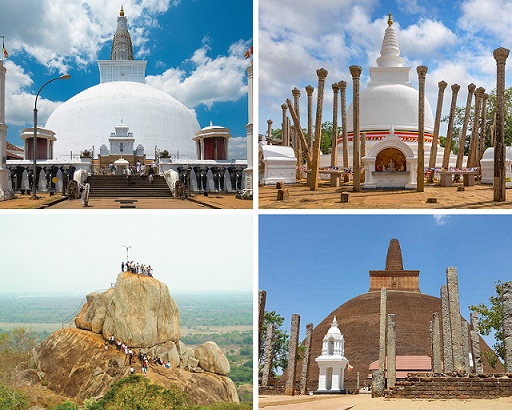
Jetavanaramaya
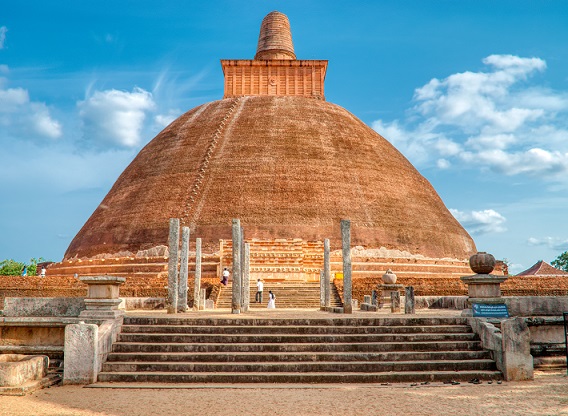
Jetavanaramaya is a significant Buddhist stupa located in the ancient city of Anuradhapura, Sri Lanka. It is one of the tallest stupas in the world and holds immense historical and religious importance.
Architecture: Jetavanaramaya showcases impressive architectural design. It was built during the reign of King Mahasena in the 3rd century CE and stands at a height of approximately 122 meters (400 feet). The stupa features a solid brick structure with intricate carvings and embellishments.
Size and scale: Jetavanaramaya is renowned for its massive size, making it one of the largest structures of its kind. It covers an area of about 5.6 hectares (14 acres) and was considered the third tallest monument in the ancient world, only surpassed by the Great Pyramids of Giza.
Religious significance: The stupa holds great religious significance for Buddhists. It is believed to enshrine relics of Gautama Buddha, making it a revered pilgrimage site. Jetavanaramaya represents the strong Buddhist influence in ancient Sri Lanka and serves as a place of worship and veneration.
Historical importance: Jetavanaramaya is a testament to the advanced engineering and architectural prowess of ancient Sri Lanka. Its construction required vast resources and a skilled workforce, showcasing the grandeur and prosperity of the Anuradhapura Kingdom.
Archaeological site: Jetavanaramaya is an important archaeological site, attracting researchers and historians. Excavations have revealed artifacts, inscriptions, and remains that provide valuable insights into the ancient civilization and its cultural practices.
Tourist attraction: Jetavanaramaya draws tourists from around the world due to its architectural splendor and historical importance. Visitors can explore the stupa, marvel at its towering structure, and learn about its cultural and religious significance.
In summary, Jetavanaramaya stands as a magnificent testament to ancient Sri Lanka’s architectural and engineering prowess. With its immense size, religious importance, and archaeological value, it remains a significant cultural and historical landmark in the region.
Isurumuniya
Isurumuniya is a Buddhist temple located in Anuradhapura, Sri Lanka. It is known for its rich historical and cultural significance, as well as its stunning rock-cut architecture.
Architecture: Isurumuniya showcases impressive rock-cut architecture. The temple is built into a rock face, creating a unique and picturesque setting. It features a main shrine room, a large carved stone courtyard, and a variety of rock-cut sculptures and carvings.
Rock-cut sculptures: One of the highlights of Isurumuniya is its collection of rock-cut sculptures. The most famous of these is the “Isurumuniya Lovers,” a beautiful carving depicting a couple in a loving embrace. Other sculptures include figures of gods, animals, and mythical creatures.
Buddhist heritage: As a Buddhist temple, Isurumuniya holds great religious significance. It is believed to have been built during the reign of King Devanampiyatissa in the 3rd century BCE, making it one of the oldest surviving Buddhist temples in Sri Lanka. The temple is dedicated to the practice and teachings of Buddhism.
Natural surroundings: Isurumuniya is set amidst lush greenery and natural surroundings, adding to its serene and tranquil ambiance. The temple is located near the Tissa Wewa reservoir, offering beautiful views of the surrounding landscape.
Archaeological importance: Isurumuniya is an important archaeological site in Sri Lanka. It has been a subject of archaeological research and study, uncovering artifacts and remnants that provide insights into ancient Sri Lankan civilization.
Cultural attraction: Isurumuniya attracts both locals and tourists due to its cultural significance. It serves as a gateway to Sri Lanka’s rich Buddhist heritage and offers a glimpse into the country’s ancient past.
Overall, Isurumuniya stands as a place of architectural beauty, religious devotion, and historical importance, offering a memorable experience for those who visit.
Lankaramaya
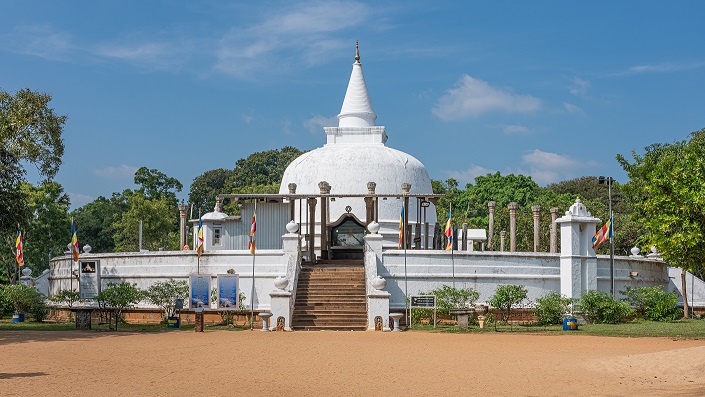
Religious Significance: Lankaramaya is a revered place of worship for Buddhists. It is believed to enshrine sacred relics or remains of Gautama Buddha, making it a significant pilgrimage site. Devotees visit the stupa to pay homage, offer prayers, and engage in religious rituals.
Architectural Splendor: Lankaramaya showcases impressive architectural design. The stupa stands at a height of approximately 40 meters (131 feet) and features a hemispherical dome structure made of brick and stone. It is adorned with intricate carvings, decorative elements, and a pinnacle, reflecting the architectural excellence of ancient Sri Lanka.
Historical Importance: Lankaramaya has historical significance dating back to the reign of King Valagamba in the 1st century BCE. The stupa was built as a memorial to protect Buddhism during a time of persecution and symbolizes the resilience and revival of Buddhism in Sri Lanka.
Cultural Heritage: Lankaramaya is a symbol of Sri Lanka’s rich cultural heritage and its deep connection to Buddhism. It represents the religious devotion and spiritual practices that have shaped the country’s identity over the centuries.
Archaeological Site: Lankaramaya is an important archaeological site, attracting researchers and historians. Excavations have revealed ancient artifacts, inscriptions, and remnants, providing valuable insights into the history and culture of ancient Anuradhapura.
Pilgrimage Destination: Lankaramaya is a popular pilgrimage destination for Buddhists and tourists alike. Many visitors come to seek spiritual solace, explore the serene surroundings, and witness the religious rituals and practices.
In summary, Lankaramaya stands as a revered and cherished site in Sri Lanka, embodying the religious and cultural heritage of the country. Its religious significance, architectural splendor, historical importance, and role as a pilgrimage destination make it an integral part of Sri Lanka’s cultural and spiritual landscape.
Abayagiriya
Abhayagiriya, also known as Abhayagiri Monastery, is a prominent Buddhist monastery complex located in Anuradhapura, Sri Lanka.
Religious Significance: Abhayagiriya was a prominent Buddhist monastery during ancient times and played a vital role in the development and propagation of Buddhism in Sri Lanka. It served as a center for Buddhist teachings, meditation, and religious practices.
Monastic Complex: Abhayagiriya comprised a vast complex of buildings, including monastic dwellings, meditation halls, libraries, and stupas. It was home to a large community of monks, creating a spiritual and educational hub.
Academic Center: Abhayagiriya was renowned for its scholarly activities and intellectual pursuits. It housed a prestigious Buddhist learning institution where monks studied Buddhist scriptures, philosophy, and other subjects, contributing to the spread of knowledge and learning.
Architectural Splendor: Abhayagiriya featured impressive architectural structures and monuments. The complex included grand stupas, elaborate statues, moonstones (decorative stone slabs), and other decorative elements, showcasing the architectural excellence of ancient Sri Lanka.
Historical Importance: Abhayagiriya has historical significance as one of the major monastic complexes in ancient Sri Lanka. It flourished during different periods and played a pivotal role in shaping the religious and cultural landscape of the region.
Cultural Heritage: Abhayagiriya represents Sri Lanka’s rich cultural heritage and its deep-rooted connection to Buddhism. It exemplifies the country’s religious traditions, architectural styles, and the ancient monastic way of life.
Archaeological Site: Abhayagiriya is an important archaeological site that has been excavated and preserved. The site has yielded numerous artifacts, inscriptions, and ruins, providing valuable insights into ancient Sri Lankan civilization and Buddhist monasticism.
Pilgrimage Destination: Abhayagiriya continues to be a popular pilgrimage destination, attracting both local devotees and tourists. Visitors come to experience the spiritual ambiance, explore the archaeological remains, and pay homage to the historical and religious significance of the site.
In summary, Abhayagiriya stands as a significant religious and cultural site in Sri Lanka. Its religious importance, historical significance, architectural splendor, and role as an archaeological and pilgrimage destination make it a revered and cherished part of Sri Lanka’s heritage.
Lovamahapaya
Lovamahapaya was built during the 2nd century BCE by King Dutugemunu. It was originally intended as a nine-story structure, but it is unclear whether it was completed to its full height. The palace was primarily constructed of wood, with a bronze roof, giving it its name, “Brazen Palace.”
Lovamahapaya was a massive structure, covering an extensive area and featuring a grid-like layout. The palace was supported by stone pillars, with each floor having numerous chambers. The uppermost floor was believed to house a large image of the Buddha.
Although referred to as a palace, Lovamahapaya was not a royal residence but rather a center for monastic activities. It served as a dwelling place for a large number of monks and provided a space for religious assemblies and discussions.
Lovamahapaya is a popular tourist attraction in Anuradhapura. Visitors can explore the remains of the palace, walk among the stone pillars, and imagine the grandeur of the structure. It offers a glimpse into the ancient splendor of Anuradhapura’s architectural heritage.
Mihintale
Mihintale is known as the cradle of Buddhism in Sri Lanka. It is believed to be the site where Arahat Mahinda, the son of Emperor Ashoka of India, met King Devanampiya Tissa of Sri Lanka in 247 BCE. This encounter led to the conversion of the king and the establishment of Buddhism as the state religion.
Mihintale is considered a holy mountain by Buddhists. It consists of a series of rock formations, caves, and monastic structures spread across the hillside. The mountain is believed to have been visited by the Buddha himself during his third visit to Sri Lanka.
Sacred Mountain – It consists of a series of rock formations, caves, and monastic structures spread across the hillside. The mountain is believed to have been visited by the Buddha himself during his third visit to Sri Lanka.
Aradhana Gala (Meditation Rock) – Stone slab where Arahat Mahinda is said to have meditated. It offers a serene and peaceful atmosphere for meditation and reflection. Visitors can climb to the top of the rock to experience the panoramic views of the surrounding landscape.
Ambasthala Dagoba – This stupa is believed to mark the spot where Arahat Mahinda and King Devanampiya Tissa first met.
Monastic Complex – Mihintale houses several monastic structures, including rock caves used by monks for meditation and dwelling. The ruins of ancient stupas, image houses, and other structures can be explored, providing insights into the religious and architectural history of the site.
Mihintale Poson Perahera: Mihintale is particularly vibrant during the Poson festival (June month), which commemorates the introduction of Buddhism to Sri Lanka. The festival includes colorful processions, religious ceremonies, and cultural performances, attracting a large number of devotees and tourists.
Thanthirimale Raja Maha Viharaya
Thanthirimale Raja Maha Viharaya dates back over 2,500 years and is believed to have been visited by Lord Buddha himself during his third visit to Sri Lanka. It is said that the Buddha left his footprint on a rock at this sacred site.
The highlight of Thanthirimale Raja Maha Viharaya is the large rock with a footprint believed to be that of the Buddha. This footprint, known as the “Sri Padaya” or “Sacred Footprint,” is highly venerated by Buddhists and is a focal point of devotion and pilgrimage.
The temple complex features a magnificent stupa, known as Thanthirimale Stupa. It is believed to have been built by King Devanampiya Tissa, who was responsible for introducing Buddhism to Sri Lanka. The stupa stands as a testament to the ancient architectural skills and Buddhist heritage of the region. The temple also includes several monastic structures and rock caves where monks resided and practiced meditation.
Several archaeological excavations have taken place at Thanthirimale Raja Maha Viharaya, uncovering ancient artifacts, statues, inscriptions, and other remnants of the past. These findings provide valuable insights into the history, art, and culture of the region.
The temple is a popular destination for Buddhist pilgrims from Sri Lanka and around the world.
Mahamevnawa Gardens
Mahamevnawa Gardens is home to a thriving monastic community of Buddhist monks who adhere to the teachings of the Theravada tradition. The monastery follows strict rules and regulations, providing a disciplined environment for monastic practice and spiritual development.
It was created by King Mutasiva during his reign from 367 – 307 BC. The king is renowned in Sri Lankan history as the first king who structured a park in the island. King Mutasiva is the son of King Pandukabhaya, who is the founder of the city of Anuradhapura. Mahamevnawa is also known as “Mahamegha” which literally translates to “heavy rainfall”. There was unusually heavy rainfall at the auspicious time the park was being started which aptly named it this way.
The Mahamevna Uyana has four heritage sites of importance. The Sacred Sri Maha Bodhi, the Samadhi Buddha Statue, the Ruwanweliseya and the Thuparama stupas are monuments with immense significance, not only for their resilience over the time, but more so because of the resplendent history and artistry that surrounds their construction.
Mahamevnawa Gardens is a popular destination for Buddhist pilgrims, both from Sri Lanka and abroad.
Ritigala
Ritigala has a rich history dating back to the ancient times of Sri Lanka. It is believed to have been inhabited by Buddhist monks as early as the 1st century BCE. The mountain range served as a renowned monastic complex and a center for meditation and spiritual practice.
The ruins of an extensive monastic complex can be found atop Ritigala. The complex includes a series of stone steps, terraces, meditation platforms, cave dwellings, and water reservoirs. The intricate stone architecture and the secluded location of the complex contribute to its unique charm.
Ritigala is known for its diverse flora, including a wide variety of medicinal plants and herbs. In ancient times, the monks residing in Ritigala cultivated herbal gardens and used their knowledge of medicinal plants for healing purposes.
Ritigala has been the site of significant archaeological discoveries. Excavations have revealed inscriptions, sculptures, and other artifacts that provide insights into the ancient Buddhist monastic life and the cultural practices of the time. The remains of ancient irrigation systems and water management structures are also notable features.
Ritigala is characterized by its scenic landscapes, dense forests, and diverse wildlife. The mountain range is home to a variety of plant and animal species, including endemic and endangered species. It offers opportunities for nature lovers and hikers to explore its trails and appreciate the beauty of the surrounding environment.
Location– It is situated approximately 43 kilometers northeast of Anuradhapura and can be reached by traveling along the Dambulla-Anuradhapura Road (A6).
#Archaeological Sites# Sri Lanka Travel Places#
Polonnaruwa
Polonnaruwa, a UNESCO World Heritage Site in Sri Lanka, holds immense archaeological importance and stands as a mesmerizing tourist attraction. This ancient city served as the capital of Sri Lanka from the 11th to the 13th century, showcasing the remarkable architectural and engineering skills of the time. The sprawling archaeological complex is home to well-preserved ruins and structures that paint a vivid picture of a glorious past.
As you wander through the ruins of Polonnaruwa, you’ll be transported back in time, walking in the footsteps of kings and nobles. The Royal Palace, with its intricate carvings and sprawling layout, provides a glimpse into the opulence and grandeur of the ancient rulers. The Gal Vihara, featuring four majestic statues of the Buddha carved from solid rock, is a marvel of artistic expression. Each statue exudes a sense of serenity and spirituality, leaving visitors in awe of the ancient craftsmanship.
Beyond the architectural wonders, Polonnaruwa’s archaeological sites are set against a backdrop of breathtaking natural beauty. The shimmering waters of the Parakrama Samudra, a massive man-made reservoir, add a sense of tranquility to the surroundings. The lush greenery, swaying palm trees, and occasional sightings of wildlife further enhance the charm of the ancient city.
A visit to Polonnaruwa is an immersive journey into the history and heritage of Sri Lanka. The archaeological sites not only captivate with their beauty and craftsmanship but also tell stories of a bygone era. It’s an experience that combines cultural exploration with natural splendor, leaving a lasting impression on every traveler fortunate enough to wander through this captivating ancient city.
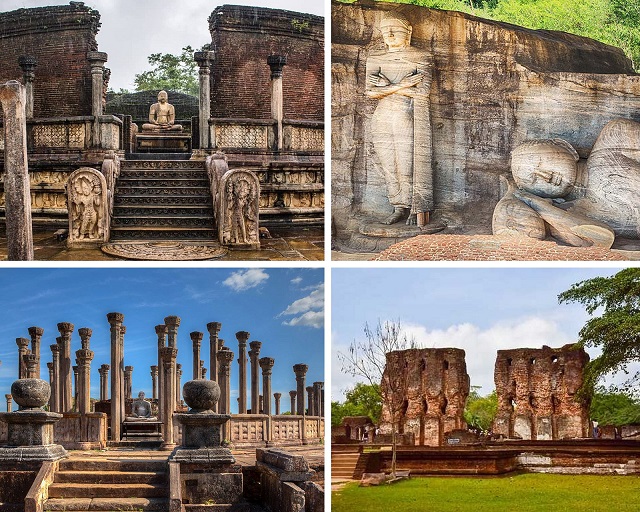
King Parakramabahu Palace
The palace is situated in the northeastern part of the ancient city. It covers a large area, indicating the grandeur and importance of the royal residence. The palace complex consists of multiple buildings, halls, and chambers, arranged in a strategic manner.
Architectural Features: The King Parakramabahu Palace exhibits impressive architectural features that reflect the artistic and engineering skills of the time. The structures are made of brick and stone, with intricate carvings and decorative elements. The palace showcases a blend of Sinhalese and South Indian architectural styles.
Audience Hall: The most prominent structure within the palace complex is the Audience Hall (Vijayothpaya). It is a large raised platform with rows of finely carved stone columns, which supported a wooden roof. The Audience Hall was the place where the king held audiences with his subjects, conducted official ceremonies, and received foreign dignitaries.
Royal Quarters: The palace complex also housed the private quarters of the king, known as the King’s Quarters. These chambers included living spaces, bedrooms, and other facilities that catered to the needs of the royal family. The design and layout of the King’s Quarters showcased the luxurious lifestyle of the king and his entourage.
Water Management: The King Parakramabahu Palace complex featured an advanced water management system. It had a sophisticated network of tanks, canals, and reservoirs that ensured a steady water supply for the palace and the surrounding areas.
Visiting the King Parakramabahu Palace in Polonnaruwa allows visitors to appreciate the architectural brilliance of the ancient kingdom and gain insights into the royal lifestyle of that era. It stands as a testament to the grandeur and sophistication of the Polonnaruwa civilization and is a significant heritage site that contributes to our understanding of Sri Lanka’s rich history.
Dalada Maluwa
The Vatadageya is a significant architectural structure and a Buddhist shrine located within the ancient city of Polonnaruwa in Sri Lanka.
Location and Purpose: The Vatadageya is situated in the Quadrangle area of the ancient city of Polonnaruwa. It is believed to have been constructed during the reign of King Parakramabahu the Great (1153-1186 AD). The Vatadageya served as a protective enclosure for a sacred relic, possibly a tooth relic of the Buddha or another significant Buddhist relic.
Architectural Design: The Vatadageya follows a circular design, which is a unique feature of Sri Lankan architecture during that era. It is a small building with a circular platform surrounded by a concentric row of stone pillars. The outermost row of pillars is adorned with exquisitely carved stone guardstones (muragalas). The entrance to the Vatadageya is through a stone staircase.
Decorative Elements: The Vatadageya is adorned with intricate stone carvings, depicting various symbols, figures, and mythical creatures. The carvings include lotus motifs, meditating Buddhas, guardian deities, and other decorative elements. These carvings showcase the artistic and architectural skills of the ancient Sri Lankan craftsmen.
Relic House: At the center of the circular platform, there is a small shrine known as the relic house. It is believed to have once housed the sacred relic.
Spiritual Significance: The Vatadageya is considered a sacred site by Buddhists and holds religious and historical significance. It represents an important place of worship and devotion for Buddhists in Sri Lanka. Visitors often offer prayers, make offerings, and engage in religious rituals at the Vatadageya.
The Vatadageya, also known as the Dalada Maluwa, is an architectural marvel that reflects the rich Buddhist heritage and the artistic achievements of ancient Sri Lanka. It stands as a testament to the skill and craftsmanship of the period and continues to be a revered site of pilgrimage and cultural interest.
Nissanka Latha Mandapaya
Location and Purpose: The Nissanka Latha Mandapaya is situated in the Quadrangle area of Polonnaruwa, close to the Rankot Vihara stupa. It was constructed during the reign of King Nissanka Malla (1187-1196 AD) and is believed to have served as an assembly hall or a place for religious gatherings.
Architectural Design: The Nissanka Latha Mandapaya is a raised platform with elaborately carved stone pillars. The platform is rectangular in shape and has a flight of steps leading to it. The pillars are adorned with intricate carvings of various floral motifs, including the lotus, vine, and liana patterns. The roof of the structure is no longer present, but it is believed to have been made of wood or other perishable materials.
Decorative Elements: The highlight of the Nissanka Latha Mandapaya is its intricate stone carvings. The pillars feature exquisite detailing, including intricate scrollwork, foliage, and mythical creatures. The carvings showcase the skill and craftsmanship of ancient Sri Lankan artisans.
Historical Significance: The Nissanka Latha Mandapaya is considered a significant historical and architectural site in Polonnaruwa. It represents the artistic and cultural achievements of the Polonnaruwa civilization and provides insights into the religious and social practices of the time.
Visiting the Nissanka Latha Mandapaya allows visitors to appreciate the intricate stone carvings and architectural grandeur of the ancient city of Polonnaruwa. It stands as a testament to the rich history and cultural heritage of Sri Lanka and continues to be a popular attraction for tourists and history enthusiasts.
Pothgul Viharaya (Aniciant Library)
Location: The Pothgul Viharaya is situated within the Quadrangle area of the ancient city of Polonnaruwa. It is located near the Rankot Vihara and the Nissanka Latha Mandapaya.
Purpose and History: The Pothgul Viharaya is believed to have been a library or a repository of ancient Buddhist texts during the Polonnaruwa Kingdom. It was likely a center for Buddhist scholarship and education.
Architectural Features: The Pothgul Viharaya consists of a rectangular-shaped building with a raised platform. The structure is made of stone, and the entrance is marked by a stone doorway. The walls of the building are adorned with intricate carvings, depicting various decorative motifs, floral patterns, and mythological figures.
Relic Chamber: Inside the Pothgul Viharaya, there is a small relic chamber that is thought to have housed sacred Buddhist relics. The chamber has a stone slab with a central hole, possibly used for securing the relic casket.
Historical Significance: The Pothgul Viharaya is considered an important archaeological site that sheds light on the intellectual and educational pursuits of the ancient Polonnaruwa Kingdom. It provides insight into the advanced level of knowledge and learning that existed during that time.
Visiting the Pothgul Viharaya allows visitors to witness the remnants of an ancient library and appreciate the architectural and historical significance of the Polonnaruwa Kingdom. It serves as a reminder of the intellectual and cultural heritage of the period and offers glimpses into the Buddhist traditions and scholarly pursuits of ancient Sri Lanka.
Alahana Pirivena
Location: Alahana Pirivena is situated in the southern part of the ancient city of Polonnaruwa, close to the Alahana Parivena Stupa and the Gal Vihara.
Historical Significance: Alahana Pirivena was established during the Polonnaruwa Kingdom and served as a prominent center for monastic education and learning. It played a vital role in the dissemination and preservation of Buddhist teachings and scholarship during that time.
Role as a Monastic Complex: Alahana Pirivena functioned as a residential monastery for Buddhist monks, providing them with accommodation and facilities for meditation, study, and religious practices. It was a place where monks received education, engaged in spiritual practices, and contributed to the religious and intellectual development of the period.
Architectural Features: The architectural remains at Alahana Pirivena include several buildings, stupas, and other structures. The remains suggest the presence of a large complex with multiple structures, including living quarters for monks, meditation halls, libraries, and possibly lecture halls.
Ruins and Restoration: Over the centuries, Alahana Pirivena fell into ruin and was covered by vegetation. However, restoration efforts have been undertaken to preserve and protect the site. Visitors can explore the remnants of the ancient monastery and gain insights into its past glory and significance.
Archaeological Exploration: Archaeological excavations at Alahana Pirivena have unearthed various artifacts, including stone sculptures, inscriptions, and pottery fragments, which provide valuable insights into the history, culture, and religious practices of the Polonnaruwa Kingdom.
Visiting Alahana Pirivena allows visitors to experience the serene and historical atmosphere of an ancient Buddhist monastery. It offers a glimpse into the spiritual and intellectual pursuits of the Polonnaruwa era and provides an opportunity to appreciate the cultural and religious heritage of Sri Lanka.
Gal Potha stone inscription (Stone Book)
The Gal Potha is situated within the Quadrangle area of the archaeological site in Polonnaruwa. It is located near the famous Gal Viharaya.
Description: The Gal Potha is a massive stone slab that serves as a horizontal inscription. It measures about 9 meters (30 feet) in length and is believed to weigh around 25 tons. The slab is made of granite and is positioned on a stone platform.
Inscriptions: The Gal Potha features inscriptions written in ancient Sinhala script, known as “Brahmi script.” The inscriptions are attributed to King Nissanka Malla (1187-1196 AD) of the Polonnaruwa Kingdom. The text provides details about the king’s genealogy, his accomplishments, and the history of the kingdom.
Symbolism and Purpose: The Gal Potha is considered a monumental proclamation of the king’s achievements and serves as a testament to the glory of the Polonnaruwa Kingdom. It was likely meant to establish the king’s legitimacy, communicate his power and authority, and provide a historical record for future generations.
Artistic Elements: The Gal Potha is decorated with intricate carvings and decorative motifs. The edges of the slab feature a pattern resembling flames, while the central part displays a carved lotus motif. The carvings highlight the artistic skills prevalent during the Polonnaruwa period.
Visiting the Gal Potha allows visitors to observe a remarkable ancient stone inscription and gain insights into the history, culture, and achievements of the Polonnaruwa Kingdom. It stands as an important historical artifact, contributing to our understanding of Sri Lanka’s past and the significance of the Polonnaruwa era.
Sathmahal Prasada
The Sathmahal Prasadaya, also known as the Seven-Storey Building, is an architectural marvel built during the reign of King Parakramabahu the Great (1153-1186 AD). It is constructed entirely with bricks and takes the shape of a pyramid. The base of the building is square, measuring 35 feet on each side.
Unique Design: The Sathmahal Prasadaya has a distinctive seven-story design, with each level gradually decreasing in size as it reaches the top. The structure is believed to have served as a palace or a royal residence during ancient times
Unique Design: The Sathmahal Prasadaya has a distinctive seven-story design, with each level gradually decreasing in size as it reaches the top. The structure is believed to have served as a palace or a royal residence during ancient times.
Although the Sathmahal Prasadaya is now in ruins, some remnants of the original structure still exist, allowing visitors to appreciate its former grandeur and architectural significance.
Siva Devalaya No. 1 of Polonnaruwa
Siva Devalaya No. 1 in Polonnaruwa refers to a specific Hindu temple dedicated to Lord Shiva, located within the ancient city of Polonnaruwa in Sri Lanka. Siva Devalaya No. 1 exhibits the architectural style prevalent during the Polonnaruwa Kingdom. It features stone carvings, intricate sculptures, and decorative elements. The temple follows a typical Dravidian architectural style, which is common in South India and Sri Lanka.
Siva Devalaya No. 2 of Polonnaruwa
Siva Devalaya 02 is the oldest Hindu shrine found in the ancient city of Polonnaruwa. Siva Dewalaya-02 structure its history dates back to the brief Chola period when the Indian invaded the city. Siva Devalaya No.2 is very much similar in style to the Shiva Devalaya No.1. Its unique feature is that it is built entirely of stone which is why it still stands very much as it was initially built.
Archaeological Museum
The Archaeological Museum in Polonnaruwa is a museum that showcases and preserves the rich cultural and historical heritage of the ancient city of Polonnaruwa in Sri Lanka.
Collection: The museum houses a diverse collection of artifacts discovered during archaeological excavations in and around Polonnaruwa. The collection includes sculptures, statues, pottery, coins, inscriptions, and other archaeological finds that provide insights into the history, culture, and daily life of the Polonnaruwa Kingdom.
Exhibitions: The museum showcases these artifacts through well-curated exhibitions. The exhibits are designed to provide visitors with a chronological journey through the history of Polonnaruwa, highlighting the significant periods and developments of the ancient city.
Educational and Interpretive Displays: The museum offers educational displays and interpretive panels that provide context and information about the artifacts and the historical significance of Polonnaruwa. These displays help visitors understand the cultural and historical importance of the ancient city.
Conservation and Preservation: The Archaeological Museum in Polonnaruwa plays a crucial role in the conservation and preservation of the artifacts. It employs proper conservation techniques to safeguard the objects and ensure their long-term preservation for future generations.
Visiting the Archaeological Museum in Polonnaruwa provides an opportunity to delve into the history and cultural heritage of the ancient city. It allows visitors to appreciate the craftsmanship of ancient artisans and gain a deeper understanding of the Polonnaruwa Kingdom and its influence on Sri Lankan history.
Kurunagala
Kurunegala, a city steeped in history and nestled amidst the picturesque landscapes of Sri Lanka, holds significant archaeological importance and serves as an alluring tourist attraction. With a rich and diverse heritage, the city is adorned with ancient ruins and structures that offer a fascinating glimpse into its storied past.
One of the main attractions in Kurunegala is the iconic Kurunegala Rock, a massive granite outcrop that towers over the city. Crowned by an ancient fortress known as Ethagala, the rock provides panoramic views of the surrounding countryside and serves as a testament to the city’s historical significance. Exploring the fortress ruins and climbing to its summit rewards visitors with breathtaking vistas that showcase the natural beauty of the region.
A visit to Kurunegala is an immersive journey into the cultural and historical heritage of Sri Lanka. The archaeological sites and monuments not only captivate with their ancient charm but also provide insight into the city’s rich past. Coupled with the scenic landscapes that surround Kurunegala, including lush greenery and rolling hills, this destination offers a unique blend of history, natural beauty, and cultural exploration that will leave a lasting impression on every traveler.
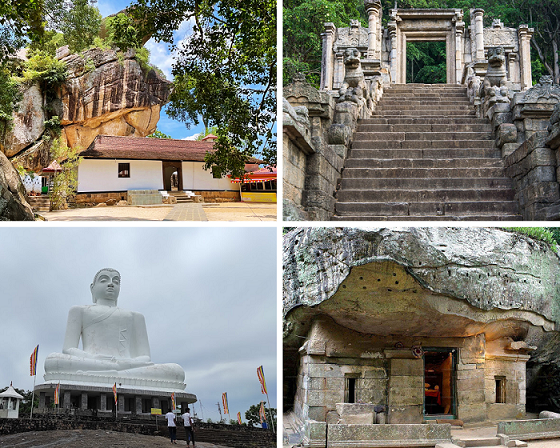
Yapahuwa
Historical Significance: Yapahuwa served as a royal capital and fortress during the 13th century. It was established by King Buvanekabahu I, who moved the capital from Polonnaruwa to Yapahuwa. The kingdom of Yapahuwa played a crucial role in Sri Lanka’s history during that period.
Rock Fortress: Yapahuwa is situated on a massive rock outcrop, similar to Sigiriya and Dambulla. The natural rock formation provided a strategic advantage for defense and protection.
Architectural Features: The fortress complex of Yapahuwa consists of several structures built on different levels of the rock. The main attraction is the elaborate entrance gateway known as the “Yapahuwa Lion Gate,” which features stone carvings of lions. Other architectural remains include a palace complex, a stupa (dagoba), image houses, and other structures.
At the top of the rock, there is a stupa that holds religious significance. Nearby, you can find an image house housing statues of the Buddha and other deities, showcasing the religious aspect of the ancient capital.
Yapahuwa features a unique water management system, including an impressive elephant-shaped pond carved out of stone. This pond was used to store water and supply it to the palace complex and surrounding areas.
Yapahuwa is known for its cultural and artistic heritage. The ruins bear witness to the architectural and sculptural achievements of the time, with intricate carvings and designs reflecting the craftsmanship of the ancient Sri Lankan artisans.
Climbing to the top of Yapahuwa offers breathtaking panoramic views of the surrounding countryside. The elevated position of the fortress allows visitors to appreciate the natural beauty and landscapes of the area.
Arankele Monastery
Location: Arankele Monastery is situated in the Arankele village, which is approximately 30 kilometers southeast of Kurunegala city. It is nestled amidst lush greenery and natural surroundings, providing a serene and peaceful atmosphere.
Historical Significance: The monastery has a rich history that dates back to the ancient Anuradhapura period (3rd century BCE to 10th century CE). It is believed to have been established during the reign of King Mahasen (3rd century CE). The monastery flourished as a center for Buddhist learning and meditation during this time.
Arankele Monastery is known as a forest monastery (Aranya). It follows the traditional Theravada Buddhist monastic practices and emphasizes meditation and seclusion in a natural forest environment.
Cave Dwellings: Arankele Monastery features a complex of natural caves that serve as dwelling places for monks. These caves, carved into the rocks, provide simple and secluded living quarters for meditation and spiritual contemplation.
Within the monastery premises, you may find ancient ruins such as stupa foundations, stone pillars, and remnants of ancient structures, reflecting the past glory of the monastery.
The monastery is situated in a picturesque location surrounded by forests and lush greenery. The natural beauty of the area adds to the peaceful ambiance and provides a conducive environment for meditation and introspection.
Panduwasnuwara Ancient Kingdom
Historical Significance: Panduwasnuwara was an important city during ancient times, believed to have been the capital of the island during the reign of King Panduvasdeva in the 4th century BCE. It served as a royal capital for several centuries and played a significant role in the country’s history.
The site of Panduwasnuwara contains the ruins of various structures that reflect the ancient architectural styles and urban planning. These include remnants of palaces, temples, monastic complexes, and other buildings, offering insights into the civilization and culture of the time.
The royal palace of Panduwasnuwara was the residence of the ruling monarchs. Although now in ruins, the remains provide a glimpse into the grandeur and layout of the ancient palace complex.
Image House and Temple: The ancient kingdom is known for its image house, which is believed to have housed important religious statues and artifacts. The temple complex, along with its architectural features, provides evidence of the religious practices and beliefs prevalent during the ancient period.
Visiting Panduwasnuwara offers the opportunity to explore the ancient remains and gain a deeper understanding of Sri Lanka’s rich history. The archaeological site provides a glimpse into the past, allowing visitors to appreciate the achievements and legacy of the ancient kingdom.
Kandy
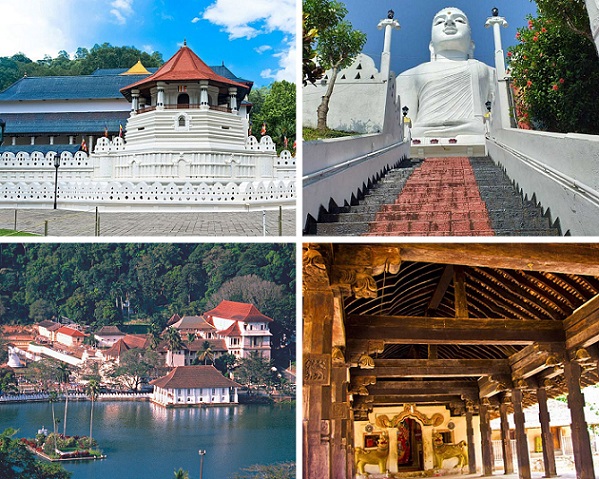
The Royal Palace of Kandy (Mahawasala)
The Royal Palace of Kandy is indeed a must-visit historical attraction in Kandy, Sri Lanka. Its location to the north of the Temple of the Tooth adds to its significance and makes it easily accessible for visitors.
The palace holds great historical importance as it was the residence of the last king of the Kandyan Kingdom, Sri Wickrama Rajasinghe. Its origins can be traced back to the 14th century, making it a repository of the kingdom’s rich heritage and legacy.
The palace complex consisted of several structures, including the King’s Palace (Raja Wasala), Royal Audience Hall (Magul Maduwa), Queen’s Palace (Meda Wasala), King’s Harem Quarters (Palle Vahale), and Queen’s Bathing Pavilion (Ulpange). These buildings were an important part of the royal court and served various functions related to the administration and residence of the royal family.
Exploring the Royal Palace allows you to witness the grandeur and splendor of the Kandyan Kingdom. The impeccable architecture of the palace, with its intricate details and design, will leave you awe-inspired.
Lankatilaka Temple
Lankatilaka Temple, also known as Lankatilaka Vihara, is a significant Buddhist temple located in Hiyarapitiya, near Kandy, Sri Lanka. It is renowned for its architectural beauty and historical importance.
The temple was built during the reign of King Bhuvanekabahu IV in the 14th century. It is considered one of the finest examples of traditional Sinhalese temple architecture from the Gampola Kingdom period. The name “Lankatilaka” translates to “the resplendent temple of Lanka,” emphasizing its importance and grandeur.
The main feature of Lankatilaka Temple is its towering brick and stone image house (gedige) and the massive standing Buddha statue inside. The image house is adorned with intricate carvings and designs, showcasing the craftsmanship of the era. The Buddha statue, which stands at around 41 feet (12.5 meters) tall, is a remarkable sight to behold.
Visiting Lankatilaka Temple provides an opportunity to explore the architectural brilliance and cultural heritage of Sri Lanka. The serene atmosphere and beautiful surroundings make it a peaceful place for meditation and reflection.
Degaldoruwa Raja Maha Viharaya
Degaldoruwa Raja Maha Viharaya, also known as Degaldoruwa Temple, is a historic Buddhist temple located in Amunugama, near Kandy, Sri Lanka. It is renowned for its beautiful wall paintings and historical significance.
The temple was built during the Kandyan Kingdom in the 18th century and is considered a prime example of traditional Kandyan temple architecture. It was constructed by King Kirthi Sri Rajasinghe, who sought to preserve and promote Buddhism during his reign.
One of the notable features of Degaldoruwa Temple is its exquisite wall paintings, which adorn the interior walls of the temple. These murals depict various scenes from Buddhist mythology and Jataka tales, illustrating important teachings and stories related to Buddhism. The paintings are characterized by their vibrant colors, intricate details, and artistic finesse.
The temple also houses a small image house, which contains a standing Buddha statue and other statues of Buddhist deities. The tranquility and spiritual ambiance of the temple make it a serene place for devotees and visitors alike.
Visiting Degaldoruwa Temple offers a glimpse into Sri Lanka’s rich cultural and religious heritage. The temple’s historical and artistic significance, combined with its peaceful setting, make it a rewarding destination for those interested in Buddhist art and architecture.
Embekke Devalaya
Embekke Devalaya is a historic temple located in Embekka, near Kandy in Sri Lanka. It is renowned for its intricate woodwork and is considered a masterpiece of traditional Sinhalese architecture.
The temple was built during the reign of King Vikramabahu III in the 14th century. It was dedicated to the worship of the deity known as Kataragama Deviyo (Lord Murugan), as well as to the guardian deities of Saman and Vishnu.
The most striking feature of Embekka Devalaya is its elaborately carved wooden pillars, beams, and other architectural elements. These wooden carvings display exquisite craftsmanship and depict a wide range of motifs, including floral patterns, dancers, musicians, animals, and mythological figures. Each carving is unique and showcases the skill and artistry of the ancient craftsmen.
The temple complex consists of several buildings, including the main shrine, the Drummers’ Hall, and the Hewisi Mandapaya (Dancing Hall). The Drummers’ Hall is particularly noteworthy, as it features a roof supported by 18 wooden pillars, each adorned with intricate carvings.
Visiting Embekka Devalaya offers a unique opportunity to explore the rich artistic heritage of Sri Lanka and appreciate the craftsmanship of the ancient builders and craftsmen. The temple’s serene setting, surrounded by lush greenery, adds to its charm and tranquility.
Gadaladeniya Temple
Gadaladeniya Temple, also known as Gadaladeniya Raja Maha Viharaya, is a Buddhist temple located in Pilimathalawa, near Kandy in Sri Lanka. It is known for its unique blend of South Indian and Sinhalese architectural styles and its historical significance.
The temple was built in the 14th century during the reign of King Bhuvanekabahu IV by a South Indian architect named Ganesvarachari. The architectural style of Gadaladeniya Temple reflects the influence of the Dravidian architecture of South India, combined with traditional Sinhalese elements.
The main shrine of the temple is built on a stone platform and is dedicated to Lord Buddha. The walls of the shrine feature beautiful carvings and intricate designs, showcasing the artistic skills of the craftsmen of that era. The temple also houses statues of Hindu deities, such as God Vishnu and God Skanda, reflecting the harmonious coexistence of Buddhism and Hinduism in Sri Lanka.
One of the striking features of Gadaladeniya Temple is its octagonal-shaped stupa (dagoba), which is constructed in the South Indian architectural style. The stupa is adorned with decorative stone carvings and provides a unique visual appeal.
Visiting Gadaladeniya Temple offers a glimpse into the cultural and religious heritage of Sri Lanka. The serene atmosphere and picturesque surroundings make it a peaceful place for devotees and visitors to explore and appreciate the architectural beauty and historical significance of the temple.
International Buddhist Museum
Sri Dalada Maligawa kandy has established the International Buddhist Museum (IBM). It is indeed fascinating to see the development and spread of Buddhism throughout different parts of Asia and the rest of the world.
The IBM serves as a platform to showcase the diverse practices and traditions of Buddhism, both Theravada and Mahayana, followed in various countries. It allows visitors to explore the different systems of Buddhism and gain a deeper understanding of the religion as a whole.
As Buddhism spread from its birthplace in India, it adapted and evolved in different regions, incorporating local customs, beliefs, and cultural elements. The IBM provides a comprehensive view of these regional variations, highlighting the unique practices and rituals associated with Buddhism in different countries.
By visiting the International Buddhist Museum, one can gain insights into the historical, philosophical, and cultural aspects of Buddhism and appreciate the global impact of this ancient religion. It serves as an educational and enriching experience for those interested in Buddhism and its diverse manifestations.
Mathale

Sigiriya Rock
Sigiriya, also known as the “Lion Rock,” is an ancient rock fortress and a UNESCO World Heritage site located in the Matale District of Sri Lanka. It is one of the country’s most famous and iconic attractions.
History: Sigiriya dates back to the 5th century AD when it was built by King Kasyapa, who established it as his royal capital. The fortress served as a fortified palace complex and included impressive gardens, pools, and elaborate structures.
Architecture and Design: The most striking feature of Sigiriya is the massive rock formation that rises about 200 meters (660 feet) above the surrounding landscape. The fortress is situated on top of this rock, which offers breathtaking views of the surrounding countryside. The rock itself is adorned with intricate frescoes, known as the Sigiriya frescoes, depicting celestial nymphs called “Apsaras.”
Lion’s Paw Entrance: As the name suggests, the entrance to Sigiriya was designed in the shape of a lion’s paw. However, only the lion’s paws remain today, and visitors can still see the massive stone paws and a portion of the staircase that led to the summit.
Mirror Wall: The Mirror Wall is a polished wall made of a special plaster that was so well polished that the king could see his reflection in it. Today, the wall is partially covered in graffiti left by visitors over the centuries. These inscriptions offer valuable insights into the ancient culture and writings of that time.
The Summit: At the summit of Sigiriya, visitors can explore the ruins of the ancient palace complex. The remains include the foundation of the royal palace, a large stone throne believed to be used by the king, bathing pools, and other structures. The summit provides panoramic views of the surrounding landscapes, including lush greenery and the remnants of ancient gardens.
Frescoes: The Sigiriya frescoes are one of the highlights of the site. These well-preserved paintings depict female figures believed to be celestial nymphs. The frescoes showcase exceptional artistic skill and are a testament to the advanced civilization of the time.
UNESCO World Heritage Site: Sigiriya was designated as a UNESCO World Heritage site in 1982, recognizing its cultural significance and exceptional universal value. It is considered a masterpiece of urban planning, engineering, and artistry from the ancient world.
Visiting Sigiriya offers a unique opportunity to delve into Sri Lanka’s rich history and architectural wonders. It remains an iconic symbol of the country’s cultural heritage and continues to attract tourists from around the world.
Rangiri Dambulu Viharaya
Rangiri Dambulu Viharaya, also known as the Dambulla Cave Temple or the Golden Temple of Dambulla, is a renowned Buddhist temple complex located in the central part of Sri Lanka, near the town of Dambulla. It is a UNESCO World Heritage site and holds great religious and historical significance.
History: The history of Rangiri Dambulu Viharaya dates back over 2,000 years. It is believed that King Valagamba sought refuge in these caves during the 1st century BCE and later transformed them into a temple complex. The caves were further expanded and embellished by subsequent kings, making it an important religious site in Sri Lanka.
Cave Temples: The complex consists of five main caves, each of which is a separate shrine. These caves house numerous statues and murals depicting various aspects of Buddhism. The walls and ceilings of the caves are adorned with colorful frescoes that depict scenes from the life of the Buddha and other significant Buddhist figures.
Golden Buddha Statue: The largest and most impressive feature of Rangiri Dambulu Viharaya is the colossal golden Buddha statue, which measures around 14 meters (46 feet) in height. This statue is located in the first cave, known as the “Devaraja Lena” or the Cave of the Divine King.
Sacred Relics: The temple complex is said to house several sacred relics, including a golden casket containing the Buddha’s forehead bone relic. These relics are of great importance to the Buddhist community and attract pilgrims from all over the world.
Cave Paintings and Murals: The cave walls are adorned with ancient paintings and murals that showcase the artistic skill of the ancient craftsmen. These paintings depict scenes from the Jataka tales (stories of the Buddha’s previous lives) and other significant Buddhist events.
Cultural Significance: Rangiri Dambulu Viharaya is not only a place of religious importance but also a symbol of Sri Lanka’s rich cultural heritage. The temple complex has been recognized by UNESCO for its historical and artistic value, attracting visitors who are interested in exploring the country’s ancient past.
Rangiri Dambulu Viharaya stands as a testament to Sri Lanka’s Buddhist heritage and offers a unique experience for visitors seeking spiritual, historical, and artistic insights. It remains a significant pilgrimage site and a must-visit destination for those exploring the cultural wonders of the island.
Aluvihara Rock Cave Temple
History: Aluvihara Rock Cave Temple dates back to the 3rd century BCE, making it one of the oldest Buddhist temples in Sri Lanka. It is believed to have been established during the reign of King Devanampiya Tissa, who introduced Buddhism to the island. The temple gained prominence as a center for religious teachings and scriptural studies.
The Tripitaka: Aluvihara is renowned for its association with the preservation of the Tripitaka, the sacred scriptures of Buddhism. It is believed to be the place where the Buddhist scriptures were first written down in the Pali language during the 1st century BCE. The Buddhist monk Mahinda Thera and a group of scholars are said to have gathered at Aluvihara to transcribe the teachings of the Buddha onto ola (palm leaf) manuscripts.
Rock Caves: The temple complex consists of a series of caves carved into the rock face of a hill. The caves served as places of meditation and religious practice for the monks. Inside the caves, you can find ancient Buddha statues, murals, and inscriptions that depict various scenes from Buddhist mythology and teachings.
Relics and Artifacts: Aluvihara Rock Cave Temple is said to house several relics, including a Buddha’s tooth relic and other sacred objects of veneration. The temple also possesses a collection of ancient artifacts and manuscripts, some of which are preserved in a museum on the temple premises.
Religious Practices: Aluvihara continues to be an active Buddhist monastery and a place of worship. Monks reside in the temple complex, and visitors can witness their daily rituals and ceremonies. The temple attracts pilgrims and devotees who come to pay their respects and engage in meditation and religious activities.
Cultural Significance: Aluvihara Rock Cave Temple is not only a religious site but also an important cultural and historical landmark in Sri Lanka. It provides insights into the country’s ancient Buddhist heritage and the role of scriptural preservation in the spread of Buddhism.
Visiting Aluvihara Rock Cave Temple offers a chance to explore the roots of Buddhism in Sri Lanka and appreciate the cultural and historical treasures that have been preserved over centuries. It is a tranquil and spiritually uplifting place that draws both religious and curious visitors seeking a deeper understanding of Buddhism and its teachings.
Nalanda Gedige
Nalanda Gedige is an ancient archaeological site located in Matale District, Sri Lanka. It is an intriguing blend of Hindu and Buddhist architectural styles and is considered a unique example of cultural synthesis.
History: Nalanda Gedige is believed to have been built during the 8th or 9th century under the patronage of the ancient Sinhalese kings. The exact purpose of the structure remains a subject of debate among scholars, but it is speculated to have served as a place of worship for both Hindus and Buddhists.
Architecture: The architectural style of Nalanda Gedige is a fusion of Hindu and Buddhist elements, reflecting the cultural exchange and religious harmony that prevailed during that period. The main structure consists of a rectangular building with a mandapa (hall) and a sanctum. The outer walls feature elaborate carvings and decorative motifs.
Hindu Influence: The intricate carvings and motifs on the exterior of Nalanda Gedige reflect the influence of Hinduism. The figures depicted include deities like Shiva, Vishnu, and the Hindu goddesses. The carvings exhibit fine craftsmanship and attention to detail.
Buddhist Influence: The presence of a Buddhist stupa and a stone statue of the Buddha within the sanctum of Nalanda Gedige showcases the Buddhist influence on the site. The Buddha statue is in the typical meditation posture (Dhyana Mudra), symbolizing serenity and enlightenment.
Cultural Synthesis: Nalanda Gedige is considered a remarkable example of the cultural synthesis that occurred during ancient times in Sri Lanka. The blending of Hindu and Buddhist elements in a single structure highlights the religious tolerance and the harmonious coexistence of different faiths in the region.
Architectural Significance: The architectural style of Nalanda Gedige is unique and distinct from other ancient structures in Sri Lanka. It stands out as an exceptional architectural marvel due to its cross-cultural influences and the innovative combination of Hindu and Buddhist elements.
Conservation and Tourism: Nalanda Gedige underwent extensive restoration and conservation efforts to preserve its historical and architectural value. It is open to visitors who can explore the site, admire the carvings, and appreciate the cultural significance of this ancient monument.
Nalanda Gedige stands as a testament to the cultural diversity and religious harmony that existed in ancient Sri Lanka. It is a captivating archaeological site that offers a glimpse into the past and provides an opportunity to appreciate the architectural brilliance and cultural heritage of the re
Badulla
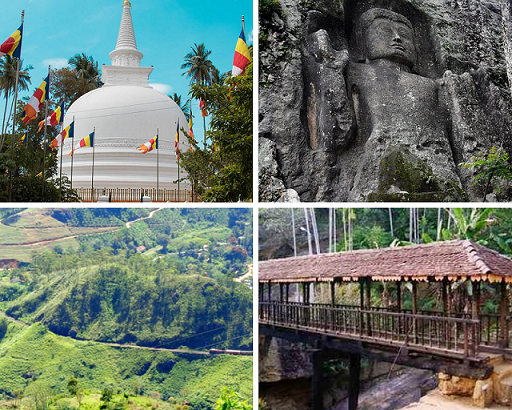
Muthiyangana Temple
Muthiyangana Temple is believed to have been visited by Lord Buddha during his third visit to Sri Lanka, approximately 2,300 years ago. According to legend, it is said that Lord Buddha’s visit to this site was to settle a dispute between two local Naga kings, Chulodara and Mahodara. The temple’s historical connection to Lord Buddha makes it an important pilgrimage site for Buddhists in Sri Lanka.
The temple showcases a mix of architectural styles influenced by various periods of Sri Lankan history. The main structures, including the stupa and the image house, feature intricate carvings and decorations. The woodwork and stone carvings exhibit the skilled craftsmanship of ancient Sri Lankan artisans.
Muthiyangana Temple houses several sacred relics, including a hair relic of Lord Buddha. These relics are highly venerated by devotees and are believed to possess spiritual power and provide blessings to those who visit the temple.
The temple grounds feature a sacred Bodhi tree (Ficus religiosa) known as the “Muthiyangana Bo Tree.” It is believed to be a sapling of the sacred Sri Maha Bodhi tree in Anuradhapura, which is considered the oldest recorded tree in the world. The presence of the Bo tree adds to the spiritual ambiance of the temple and attracts devotees for meditation and religious activities.
Muthiyangana Temple hosts an annual grand procession called the Muthiyangana Perahera. This religious pageant takes place during the month of July or August and involves a vibrant parade with traditional dancers, drummers, flag bearers, and beautifully decorated elephants. The Perahera attracts thousands of spectators, both locals and tourists, who come to witness the colorful festivities.
Muthiyangana Temple is not only a place of worship but also a cultural and historical landmark in Badulla. Its rich heritage, spiritual ambiance, and architectural beauty make it a significant attraction for both religious and cultural exploration in Sri Lanka.
Dowa Rajamaha Viharaya
Dowa Temple is renowned for its rock cave inscriptions, which provide valuable insights into the history and culture of the region. These inscriptions date back to the 1st century BC and are written in the ancient Brahmi script. They contain information about the donors who made offerings to the temple, giving a glimpse into the social and religious practices of the time.
The temple is famous for its impressive rock-cut Buddha statues. The main attraction is a 38-foot statue of Lord Buddha, carved into the face of a rock outcrop. The statue is considered one of the largest rock-cut Buddha statues in Sri Lanka. It showcases the skill and craftsmanship of ancient artisans who meticulously carved the intricate details of the statue.
The interior walls of the rock cave at Dowa Temple feature ancient paintings and murals. These artworks depict scenes from Buddhist folklore, Jataka tales (stories about the previous lives of Buddha), and other religious motifs. The paintings provide a visual representation of Buddhist teachings and serve as a cultural and historical treasure.
Dowa Temple is situated amidst scenic natural surroundings, adding to its charm. It is nestled amidst lush greenery, offering a peaceful and serene atmosphere for visitors and devotees. The temple is located on a hill, providing panoramic views of the surrounding countryside.
Dowa Rajamaha Viharaya also hosts an annual procession known as the Dowa Perahera. This vibrant cultural event features traditional dancers, drummers, and decorated elephants parading through the streets, accompanied by religious rituals and ceremonies. The Perahera draws large crowds of spectators who come to witness and participate in the festivities.
Dowa Rajamaha Viharaya is a place of historical, cultural, and religious importance in Badulla. Its rock cave inscriptions, rock-cut Buddha statues, and scenic location make it a significant site for those interested in exploring Sri Lanka’s rich Buddhist heritage.
Kalutara
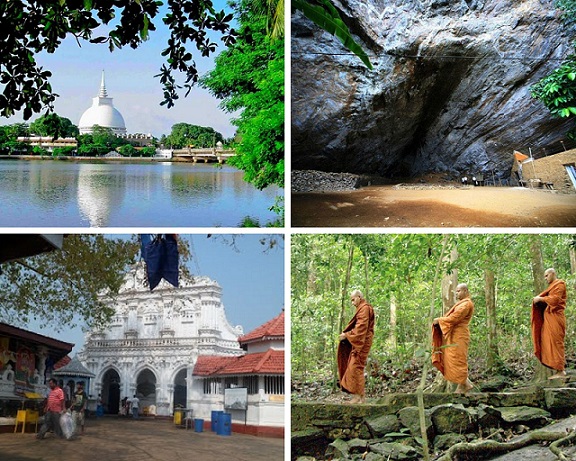
Pahiyangala (Fa-Hien) Caves
Pahiyangala, also known as Fa-Hien Cave, is a historic and archaeological site located in the Kalutara district of Sri Lanka. It is situated in the village of Yatagampitiya, approximately 40 kilometers north of Kalutara town.
Pahiyangala is renowned for being one of the largest natural rock caves in Sri Lanka, with a rich history dating back thousands of years. The cave has significant archaeological importance, as it has been found to contain evidence of human habitation dating back to the prehistoric era.
According to archaeological findings, Pahiyangala Cave was inhabited by prehistoric humans around 37,000 years ago. Excavations at the site have unearthed stone tools, artifacts, and skeletal remains, providing valuable insights into the ancient civilizations that once thrived in the region.
The cave itself is a fascinating geological formation. It is formed by a large rock overhang and has a massive entrance, creating an awe-inspiring sight. The interior of the cave is vast, with high ceilings and several chambers. Exploring the cave allows visitors to witness the impressive rock formations and gain a sense of the ancient history that unfolded within its walls.
Apart from its archaeological significance, Pahiyangala also offers panoramic views of the surrounding landscape. The site is nestled amidst lush greenery and offers glimpses of the rural countryside and the Kalu Ganga (Black River) flowing nearby.
Visitors to Pahiyangala can take guided tours of the site to learn about its historical importance, geology, and the lifestyles of prehistoric humans. The cave is easily accessible and has a staircase that leads to the entrance, making it relatively convenient for exploration.
Bodhinagala Forest Hermitage
The Bodhinagala Forest Hermitage, also known as Bodhinagala Raja Maha Viharaya, is a Buddhist monastery and meditation retreat located in the Kalutara district of Sri Lanka.
The hermitage is known for its historical and religious significance. It is believed to have been established during the reign of King Parakramabahu VI in the 15th century. The ancient rock cave temple within the premises contains exquisite wall paintings and stone carvings, showcasing the rich heritage of Sri Lankan Buddhist art.
The Bodhinagala Forest Hermitage is renowned as a meditation center where monks and practitioners engage in intensive meditation retreats. The tranquil surroundings, abundant nature, and serene atmosphere provide an ideal setting for inner reflection and mindfulness practice. Visitors can participate in meditation sessions, learn from experienced meditation teachers, and experience the peaceful ambiance of the hermitage.
The hermitage is also known for its wildlife sanctuary. The Bodhinagala Forest Reserve is home to various species of animals and birds, including monkeys, deer, and a wide range of avian species. Exploring the forest trails allows visitors to appreciate the natural beauty and biodiversity of the area.
Visiting the Bodhinagala Forest Hermitage offers a unique opportunity to immerse oneself in Buddhist culture, engage in meditation, and connect with nature. It is advisable to check the availability of meditation programs and seek permission before visiting, as it is primarily a place for spiritual practice and may have specific guidelines for visitors.
Jaffana
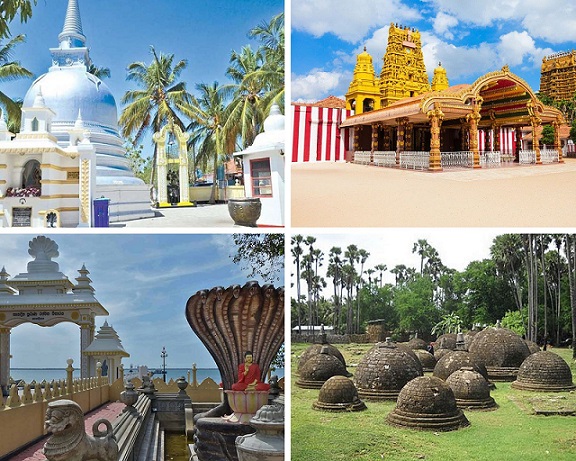
Dambakola Patuna
Dambakola Patuna, also known as Dambakola Patuna Sangamitta Temple, is an ancient historical site located in Jaffna, Sri Lanka.
Dambakola Patuna is believed to be the place where Sangamitta, the daughter of Emperor Ashoka of India, arrived with a sapling of the sacred Bodhi tree. The Bodhi tree is the tree under which Lord Buddha attained enlightenment. It is said that Sangamitta landed at Dambakola Patuna with the sacred sapling, which was later planted in Anuradhapura, becoming the Jaya Sri Maha Bodhi, one of the most sacred sites for Buddhists in Sri Lanka.
The site is located in the coastal village of Dambakola Patuna, about 30 kilometers north of Jaffna town. It features a serene and picturesque setting near the sea. The area has a historical ambiance and is dotted with ancient ruins, including the remains of a Buddhist stupa and other structures.
Today, Dambakola Patuna is a place of pilgrimage for Buddhists, and devotees visit to pay their respects and seek blessings. The site attracts both locals and tourists interested in exploring its historical and religious significance. It provides an opportunity to learn about the early Buddhist influence in Sri Lanka and the island’s connections to Emperor Ashoka’s era.
While visiting Dambakola Patuna, it’s advisable to dress modestly and show respect for the religious site. It’s also recommended to check the local conditions and any guidelines or restrictions before planning a visit.
Naagadeepa Viharaya
Naagadeepa Viharaya, also known as Nagadeepa Temple or Nagadeepa Rajamaha Viharaya, is a prominent Buddhist temple located on Nagadeepa Island in the Jaffna District of Sri Lanka. It is an important pilgrimage site for Buddhists and holds great religious significance.
According to Buddhist tradition, Naagadeepa Viharaya is believed to be one of the places where Lord Buddha visited during his second visit to Sri Lanka. It is said that Lord Buddha came to the island to settle a dispute between two Naga kings, Chulodara and Mahodara, who ruled over Nagadeepa at the time. Lord Buddha mediated and resolved the conflict peacefully, establishing harmony and promoting Buddhism in the region.
The temple complex at Naagadeepa Viharaya features several structures, including the main shrine, a stupa, and various statues depicting Lord Buddha and other important figures in Buddhist mythology. The sacred Bo tree (Bodhi tree), which is believed to have been planted during Lord Buddha’s visit, is also revered by devotees.
Devotees visit Naagadeepa Viharaya to offer prayers, make offerings, and seek blessings. The temple is especially crowded during religious festivals and full moon days, attracting pilgrims from different parts of Sri Lanka.
To reach Naagadeepa Viharaya, visitors need to take a short boat ride from the mainland to Nagadeepa Island. It is advisable to dress modestly and maintain respectful conduct while visiting the temple.
Kandarodei / Kadurugoda Buddhist Temple
Kandarodai, also known as Kadurugoda, is indeed an important archaeological site in Jaffna, Sri Lanka.
Kandarodai is an ancient Buddhist site located approximately 14 kilometers from Jaffna town. It is known for its collection of small dagobas (stupas) made of limestone. During archaeological excavations, around 62 dagobas were discovered, making it one of the largest concentrations of dagobas in Sri Lanka.
The construction of the dagobas at Kandarodai is believed to have taken place during the Anuradhapura Era, showcasing the rich ancient history of the area. The use of limestone in their construction is notable, as it differs from the typical brick or stone construction found in other Buddhist sites in Sri Lanka.
Apart from the dagobas, various artifacts have been found at Kandarodai, including coins, a Buddha statue, stone inscriptions, and foreign materials. These findings suggest that the site had connections with trade and was influenced by Buddhism.
The presence of stone inscriptions further attests to the historical significance of Kandarodai. These inscriptions provide insights into the ancient culture and traditions of the region.
Kandarodai is a site of both archaeological and religious importance, attracting visitors interested in exploring Sri Lanka’s ancient history and Buddhist heritage. The collection of small dagobas and the intriguing artifacts make it a fascinating destination for history enthusiasts.
Jaffna Fort
The Jaffna Fort, also known as the Dutch Fort, is a historic fortification located in the city of Jaffna in northern Sri Lanka. It is one of the prominent landmarks in Jaffna and holds significant historical and architectural importance.
The fort was originally built by the Portuguese in the early 17th century. However, it underwent several transformations and expansions under subsequent colonial powers, including the Dutch and the British. The fort’s current structure reflects a blend of Portuguese, Dutch, and British architectural styles.
The Jaffna Fort served as a strategic military stronghold for these colonial powers, given its location overlooking the Jaffna Peninsula and its access to the surrounding waters. The fort was designed with defensive walls, bastions, and a moat for protection.
The fort covers a vast area and is surrounded by high ramparts and sturdy walls. Within its confines, there are several buildings and structures, including a clock tower, a chapel, barracks, and administrative buildings. The fort’s architecture showcases the colonial influence and provides a glimpse into the history of Jaffna under foreign rule.
During the Sri Lankan civil war, the Jaffna Fort was heavily damaged and suffered from neglect. However, efforts have been made to restore and preserve the fort in recent years. Today, it stands as a testament to Jaffna’s rich history and serves as a popular tourist attraction.
Visitors to the Jaffna Fort can explore the premises, walk along the ramparts, and enjoy panoramic views of the surrounding area. The fort offers a peaceful ambiance and is a great spot for photography and historical exploration.
In addition to its historical and architectural significance, the Jaffna Fort occasionally hosts cultural events, exhibitions, and performances, showcasing the local heritage and arts.
Trincomalee

Seruwawila Mangala Raja Maha Viharaya
Seruwawila Mangala Raja Maha Viharaya, also known as Seruwila Raja Maha Viharaya, is a prominent Buddhist temple located in Seruwila, Trincomalee District, Sri Lanka. It is a sacred place of worship and pilgrimage for Buddhists, with a history dating back thousands of years.
History: Seruwawila Mangala Raja Maha Viharaya is believed to have been established during the reign of King Kavantissa, who ruled in the 2nd century BCE. The temple gained significant importance during the ancient Anuradhapura Kingdom and continued to be revered throughout different periods of Sri Lankan history.
Sacred Relic: The temple is known for enshrining a sacred relic, believed to be a lock of hair from the head of Lord Buddha. This relic is venerated by devotees and attracts pilgrims from various parts of the country.
Architecture: The temple complex features a blend of ancient and modern architectural styles. The main shrine is adorned with intricate carvings and sculptures, reflecting the rich Buddhist heritage of Sri Lanka. The stupa (dome-shaped structure) at Seruwawila is also a notable feature of the temple.
Spiritual Significance: Seruwawila Mangala Raja Maha Viharaya holds great spiritual significance for Buddhists. It is believed that paying homage to the sacred relic and engaging in religious activities at the temple can bring blessings, protection, and spiritual merit to devotees.
Visiting Seruwawila Mangala Raja Maha Viharaya offers a chance to experience the serene surroundings, engage in religious practices, and witness the rich cultural heritage of Sri Lanka. As with any religious site, it is important to dress modestly and show respect for the traditions and customs observed at the temple.
Ratnapura
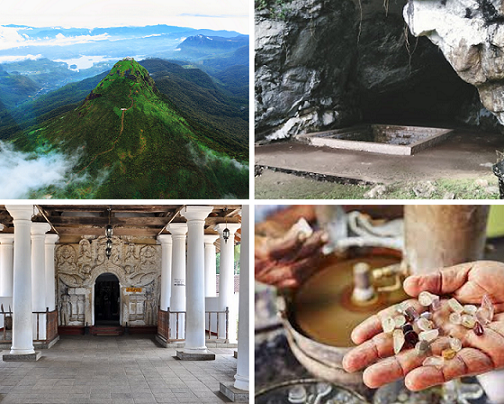
Batadombalena
Batadombalena is an important archaeological site located in Kuruwita, Sri Lanka. It holds significant historical and archaeological value, providing insights into early human habitation on the island.
Archaeological Significance: The site gained prominence when a human skeleton was discovered in 1981. This discovery marked the first scientifically excavated skeletal remains of Homo sapiens balangodensis, commonly known as the Balangoda Man. The Balangoda Man is an ancient subspecies of Homo sapiens that lived in Sri Lanka approximately 38,000 years ago.
Excavations and Findings: Extensive excavations have been carried out at Batadombalena, unearthing numerous artifacts and evidence of early human activity. Stone tools, animal bones, and fragments of pottery have been discovered, shedding light on the lifestyles and behaviors of the Balangoda Man. The site also contains a cave, believed to have been used as a shelter by early humans.
Balangoda Man: The Balangoda Man is considered one of the oldest known human populations in Sri Lanka. The skeletal remains found at Batadombalena provide valuable information about the physical characteristics, cultural practices, and technological advancements of this early human population. These findings have contributed significantly to our understanding of prehistoric human settlements in Sri Lanka.
Research and Preservation: Batadombalena and its archaeological findings are of great interest to researchers, anthropologists, and archaeologists. Ongoing studies continue to deepen our knowledge of the Balangoda Man and the ancient history of Sri Lanka. Efforts are also being made to preserve and protect the site for future generations.
Visiting Batadombalena provides a unique opportunity to witness the archaeological remnants of early human civilization in Sri Lanka.
Colombo
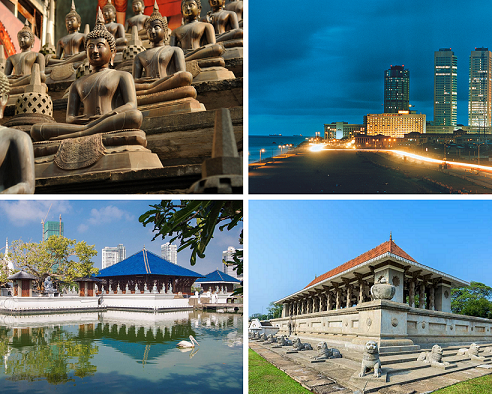
Kelaniya Raja Maha Viharaya
The Kelaniya Raja Maha Vihara, commonly referred to as the Kelaniya Temple, is a renowned Buddhist temple located in Kelaniya, Gampaha District.It is one of the most sacred Buddhist sites in the country and holds significant historical and religious importance.
The temple is believed to have been visited by Lord Buddha himself during his third visit to Sri Lanka in 500 BCE. According to legend, the temple was established to enshrine a sacred relic of Lord Buddha, a gem-studded throne (Dakkhina Jinasena Palliya). Over the centuries, the temple has undergone various renovations and expansions, reflecting the architectural styles of different eras.
The Kelaniya Temple is known for its beautiful architecture, intricate carvings, and vibrant murals that depict Buddhist teachings and stories from Buddhist mythology. The temple’s main stupa (dagoba) is a prominent feature, surrounded by smaller stupas and structures that house statues of the Buddha and other important figures in Buddhism.
Visiting the Kelaniya Temple offers a serene and spiritual experience, allowing visitors to immerse themselves in Buddhist traditions and appreciate the cultural heritage of Sri Lanka.
The Independence Square
Historical Significance: The Independence Square holds great historical importance as it commemorates Sri Lanka’s independence from British colonial rule on February 4, 1948. The site was originally a location where the formal ceremonies for the transfer of power took place.
Architectural Beauty: The Independence Square is renowned for its impressive architectural design, blending traditional and modern elements. The structure incorporates classical Sri Lankan architectural features, such as the use of intricate carvings, columns, and a distinctive roof design.
Commemorative Monument: At the center of the Independence Square stands a tall memorial tower, symbolizing the nation’s freedom. The tower features a golden statue of the first Prime Minister of Sri Lanka, Rt. Hon. D.S. Senanayake, who played a pivotal role in the country’s independence movement.
Symbol of National Unity: The Independence Square serves as a symbol of national unity and pride for Sri Lankans. It is a place where people gather to celebrate national holidays, pay tribute to national heroes, and commemorate significant events in the country’s history.
The open spaces and pathways around the Independence Square provide a popular spot for locals and tourists to engage in recreational activities. Many people visit the area for jogging, walking, and exercising amidst the tranquil surroundings.
The Independence Square stands as a testament to Sri Lanka’s journey towards independence and serves as a gathering place for the nation to remember and celebrate its freedom. Its architectural beauty, historical significance, and peaceful surroundings make it a notable landmark and a popular destination for visitors exploring Colombo.
Colombo National Museum
The Colombo National Museum, also known as the National Museum of Colombo, is the largest museum in Sri Lanka and a prominent cultural institution.
Location: The Colombo National Museum is located in the heart of Colombo, near the Victoria Park in the Cinnamon Gardens neighborhood.
History and Architecture: The museum was established in 1877 during the British colonial period and is housed in a grand colonial-style building. The architecture of the museum reflects a blend of neo-classical and Sri Lankan influences, featuring ornate facades, high ceilings, and spacious galleries.
Vast Collection: The museum boasts a vast collection of artifacts, artworks, and exhibits that represent Sri Lanka’s rich cultural heritage and history. It covers a wide range of disciplines, including archaeology, anthropology, art, numismatics, natural history, and more.
Archaeological Section: The archaeological section of the museum displays ancient artifacts and relics, providing insights into Sri Lanka’s prehistoric and ancient civilizations. It showcases pottery, sculptures, tools, jewelry, and other archaeological finds from various regions of the country.
Art Gallery: The Colombo National Museum features an art gallery that showcases a wide range of paintings, sculptures, and contemporary artworks by renowned Sri Lankan artists. The gallery provides a platform for promoting local artistic talent and appreciation of visual arts.
Cultural Artifacts: The museum houses a diverse collection of cultural artifacts, including traditional masks, traditional costumes, jewelry, musical instruments, and religious artifacts. These exhibits offer a glimpse into the vibrant cultural traditions and artistic heritage of Sri Lanka.
Educational Programs: The Colombo National Museum organizes educational programs, workshops, and lectures to promote cultural and historical awareness among visitors. These programs cater to students, researchers, and the general public, providing opportunities for learning and engagement.
The Colombo National Museum serves as a custodian of Sri Lanka’s cultural heritage and plays a vital role in preserving, promoting, and educating about the country’s rich history, art, and archaeology. It is a must-visit destination for those interested in exploring Sri Lanka’s cultural roots and deepening their understanding of the nation’s heritage.
Colombo Dutch Museum
The Colombo Dutch Museum is housed in a Dutch colonial building that dates back to the 17th century. The museum focuses on the Dutch colonial period in Sri Lanka and showcases the influence of the Dutch East India Company on the island.
Location: The museum is situated in the heart of Colombo’s Pettah neighborhood, close to the famous Wolvendaal Church, which is also a Dutch colonial heritage site.
Architecture: The building itself is a significant architectural attraction, featuring a distinctive Dutch colonial design with tall, timber-framed windows, gabled roofs, and a central courtyard. It offers a glimpse into the architectural style and construction techniques of the Dutch colonial era.
Exhibits: The museum displays a collection of artifacts, documents, and exhibits that depict various aspects of the Dutch colonial period in Sri Lanka. The exhibits cover a range of themes, including trade, administration, culture, and daily life during the Dutch rule.
Furniture and Antiques: The museum showcases antique furniture, household items, and decorative pieces from the Dutch colonial era. These items provide insights into the lifestyle and aesthetics of the Dutch settlers in Sri Lanka.
Artifacts and Archaeological Finds: Visitors can view a variety of artifacts, including coins, ceramics, weaponry, and religious objects from the Dutch period. These artifacts serve as tangible evidence of the historical interactions between the Dutch and the local population.
Visiting the Colombo Dutch Museum provides a unique opportunity to delve into Sri Lanka’s colonial history and learn about the Dutch influence on the island. The museum’s exhibits, artifacts, and architectural charm offer a captivating journey into the past, allowing visitors to gain a deeper understanding of the country’s cultural and historical roots.
Gampaha
Maligatenna Raja Maha Viharaya
The Maligathenna Cave Temple is an ancient cave temple located in a small village in the Gampaha district of Sri Lanka. Recognized as an archaeological protected site by the government, this temple is perched on top of a rock on a small hill. It boasts several very old caves, bearing evidence of its ancient origins. The history of Maligathenna Raja Maha Vihara dates back to the Anuradhapura Kingdom era, with legends suggesting that it served as a significant hiding place for kings and ministers during enemy invasions.
The temple is a magnificent sight, built atop a giant rock, offering a majestic view of the surrounding landscape. Upon entering the temple grounds, visitors can observe a mix of old and new structures. The temple is divided into two main levels: Pahala Maluwa (lower level) and Ihala Maluwa (upper level). The Pahala Maluwa includes monks’ quarters, a meditation center, the main shrine, outdoor and indoor promenades (Sakman Maluwa), a sacred bo tree, an ancient temple, and the Sri Devaraja Aakasha Chaitya Rajaya stupa. The Ihala Maluwa features a stupa, another bo tree, and a pond.
To reach the Maligathenna Temple, one must ascend an ancient flight of stone stairs, adding to the sense of adventure and history. The temple’s location atop the rock offers breathtaking views from the plateau, making it an ideal spot for photography enthusiasts. Don’t miss the opportunity to capture the beauty of the surroundings while exploring this remarkable place.
Hambantota
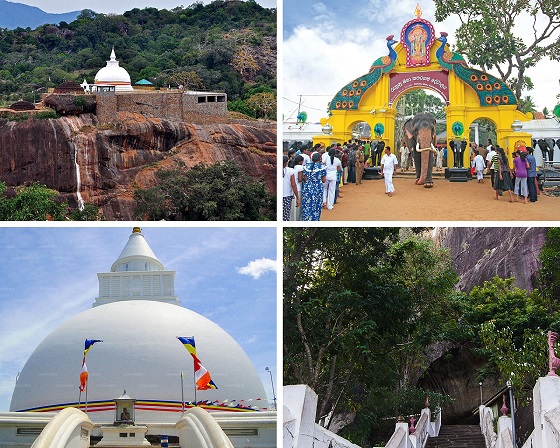
Kataragama Kiri Vehera
Historical Significance: Kiri Vehera is believed to have been built during the 6th century BC, making it one of the oldest Buddhist stupas in Sri Lanka. It is attributed to King Mahasena, who ruled the region during that time. The stupa is revered for its historical and religious significance.
Buddhist Pilgrimage Site: Kiri Vehera is a prominent pilgrimage site for Buddhists, particularly those visiting Kataragama for its religious significance. Devotees visit the stupa to pay homage, make offerings, and engage in religious practices such as meditation and chanting. It is considered a sacred place for seeking blessings, protection, and spiritual solace.
Architectural Design: The stupa is built in the traditional Sinhalese architectural style. It features a circular base and a hemispherical dome, which is believed to house relics of Lord Buddha or other venerated Buddhist monks. The stupa is adorned with intricate carvings, sculptures, and decorative elements that showcase the artistic craftsmanship of ancient Sri Lanka.
Esala Perahera: Kiri Vehera plays a significant role in the annual Kataragama Esala Perahera festival. As part of the festival, a sacred casket containing relics is carried in a grand procession around the town of Kataragama, and it is believed that the procession passes by Kiri Vehera. The festival attracts a large number of devotees and tourists who come to witness the vibrant cultural celebrations.
Meditation and Spiritual Practices: Kiri Vehera offers a serene and peaceful environment for meditation and spiritual practices. Many devotees and visitors engage in meditation and prayers near the stupa to attain inner peace and spiritual enlightenment. The tranquil surroundings and the aura of devotion make it an ideal place for introspection and reflection.
Sithulpawwa Buddhist Monastery
Historical Significance: Sithulpawwa Monastery has a history dating back over 2,000 years. It is believed to have been established during the reign of King Kavantissa, a prominent ruler in ancient Sri Lanka. The monastery gained prominence as a center for Buddhist learning and meditation during the Anuradhapura and Polonnaruwa periods.
Architectural Features: The monastery complex features a range of architectural elements, including stupas, cave temples, drip-ledged caves, and rock-cut inscriptions. The structures are adorned with ancient frescoes and murals, showcasing the artistic skills of the ancient craftsmen. The iconic stupa, standing tall amidst the natural landscape, is a notable sight.
Caves and Rock Shelters: Sithulpawwa is known for its extensive network of caves and rock shelters, which served as dwellings and meditation spaces for monks in the past. Many of these caves have been adorned with ancient paintings, depicting scenes from Buddhist folklore and the lives of the Buddha and Bodhisattvas.
Meditation and Spiritual Practices: The serene ambiance and natural surroundings of Sithulpawwa provide an ideal environment for meditation and spiritual practices. The monastery has long been associated with meditation retreats and is frequented by practitioners seeking solitude and spiritual enlightenment.
Pilgrimage Site: Sithulpawwa is considered a significant pilgrimage site for Buddhists. Devotees visit the monastery to pay homage, make offerings, and engage in religious practices. The annual Sithulpawwa Esala Perahera, a colorful procession held in July or August, attracts a large number of pilgrims and tourists.
Wildlife and Nature: Sithulpawwa Monastery is situated within the Yala National Park, known for its abundant wildlife and natural beauty. Visitors to the monastery may encounter a variety of animal species, including elephants, leopards, deer, and a wide range of birdlife. The blend of spirituality and natural surroundings makes it a unique destination for nature lovers.
Archeological Importance: The monastery complex has been the subject of archaeological studies, with excavations revealing ancient artifacts and relics. These findings contribute to a better understanding of the region’s historical and cultural heritage.
Mulkirigala Rock Temple
Mulkirigala Rock Temple, also known as Mulkirigala Raja Maha Viharaya, is a significant Buddhist temple located in the Hambantota District of Sri Lanka.
Historical Significance: Mulkirigala Rock Temple has a rich history that dates back over 2,000 years. It is believed to have been founded during the reign of King Devanampiya Tissa, one of the earliest Buddhist kings in Sri Lanka. The temple played a vital role in the spread and preservation of Buddhism on the island.
Architectural Marvel: The temple complex is comprised of a series of rock-cut caves and structures that are built against the natural rock formations. These structures feature beautiful murals, sculptures, and intricate stone carvings depicting scenes from Buddhist mythology and historical events. The rock-cut architecture is a testament to the skill and craftsmanship of ancient Sri Lankan artisans.
Seven Cave Temples: Mulkirigala Rock Temple is famous for its seven cave temples, each showcasing unique architectural and artistic elements. Each cave is a shrine filled with Buddha statues, ancient paintings, and other religious artifacts. As visitors ascend the rock, they can explore each cave temple, which gradually becomes more elevated and offers breathtaking panoramic views of the surrounding countryside.
Pilgrimage Site: The temple is considered a sacred pilgrimage site for Buddhists. Many devotees visit Mulkirigala Rock Temple to pay homage, meditate, and seek blessings. The serene and spiritual ambiance of the temple, combined with its natural beauty, creates a tranquil atmosphere conducive to introspection and meditation.
Nature and Scenic Views: Mulkirigala Rock Temple is situated amidst lush greenery, providing visitors with a chance to appreciate the natural beauty of the surrounding landscape. As visitors climb to higher levels of the temple, they are rewarded with panoramic views of the countryside, including distant mountains, paddy fields, and forests.
Visiting Mulkirigala Rock Temple offers a blend of spirituality, history, and natural beauty. The intricate cave temples, ancient art, and the tranquil setting create a memorable experience for those interested in Buddhism and cultural heritage. The temple’s location atop a rock outcrop provides not only a sense of adventure but also stunning vistas of the picturesque Hambantota District.
Ampara
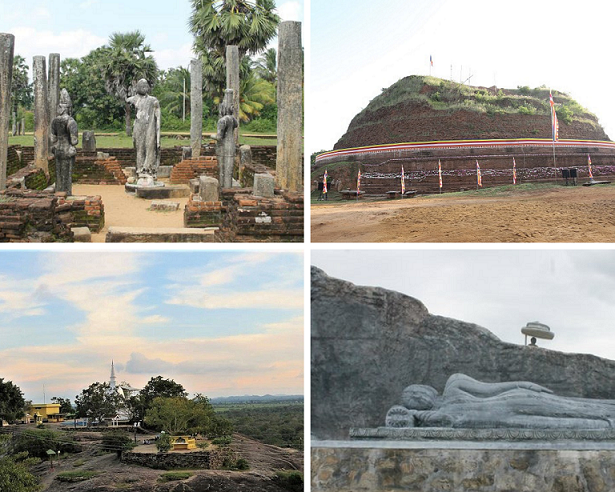
Buddhangala Monastery
Historical Significance: Buddhangala Monastery has a rich history dating back to ancient times. According to legends, it is believed to have been visited by Lord Buddha during his third and final visit to Sri Lanka. The monastery has since been an important pilgrimage site for Buddhists.
Serene Setting: The monastery is situated amidst scenic surroundings, featuring lush greenery, rock formations, and a tranquil atmosphere. The peaceful ambiance of Buddhangala provides an ideal environment for meditation, contemplation, and spiritual practices.
Sacred Stupa: At the heart of Buddhangala Monastery stands a majestic stupa (dome-shaped structure), which is considered the main focal point of the temple. The stupa is adorned with intricate designs and architectural details, attracting devotees and visitors alike.
Cave Dwellings: The area surrounding Buddhangala Monastery features a series of caves that were historically used by monks for dwelling and meditation. These cave dwellings add a sense of mystique to the monastery and offer a glimpse into the traditional monastic lifestyle.
Buddhangala Monastery serves as a spiritual sanctuary, attracting devotees, pilgrims, and individuals seeking solace and enlightenment. Its historical significance, serene setting, and cultural festivities make it a notable destination for those interested in Buddhism, meditation, and Sri Lanka’s religious heritage.
Rajagala
Historical Importance: Rajagala is believed to have been an ancient Buddhist monastic complex dating back to the 1st century BCE. The site was a thriving center for monastic activities and is associated with the Mahayana and Theravada Buddhist traditions.
The site of Rajagala contains extensive ruins and remains of ancient structures, including monastic buildings, meditation caves, stupas, ponds, and stone inscriptions. These archaeological remnants provide insights into the layout and architecture of the ancient monastic complex.
Several stupas (dome-shaped Buddhist structures) can be found at Rajagala, along with statues of the Buddha and other deities. These monuments highlight the religious and spiritual significance of the site.
Rock Inscriptions: Rajagala is known for its rock inscriptions, which provide valuable historical and linguistic information. These inscriptions, written in Brahmi and ancient Sinhala scripts, offer insights into the daily life, religious practices, and cultural context of the ancient inhabitants.
Rajagala is gaining popularity among tourists and history enthusiasts due to its cultural and archaeological importance. Visitors can explore the site, learn about its history through guided tours, and appreciate the architectural and artistic remnants of the ancient monastic complex.
Deegavapiya
Deegavapiya, also known as Deegavapi Stupa or Deegavapi Raja Maha Viharaya, is an important Buddhist religious site located in Ampara District.
Historical Significance: Deegavapiya is believed to have been established during the reign of King Saddhatissa (137-119 BCE) and is closely associated with the ancient Anuradhapura Kingdom. It is one of the 16 sacred places in Sri Lanka believed to have been visited by Gautama Buddha.
Sacred Stupa: The centerpiece of Deegavapiya is the large stupa, which is considered to be one of the most sacred Buddhist monuments in Sri Lanka. The stupa is believed to enshrine relics of Lord Buddha, making it a significant pilgrimage site for Buddhists.
Deegavapiya is not only a stupa but also a functioning Buddhist monastery. The monastery complex consists of various structures such as shrine rooms, meditation halls, monk residences, and other ancillary buildings.
Bodhi Tree: Within the premises of Deegavapiya, there is a sacred Bodhi tree, which is believed to be a sapling from the original Bodhi tree in Bodhgaya, India, under which Gautama Buddha attained enlightenment. The Bodhi tree is highly revered by Buddhists and serves as a focal point for devotional practices.
Archaeological Remains: In addition to the main stupa and monastery, there are several archaeological remains and ruins within the Deegavapiya complex. These include ancient stone inscriptions, moonstones (carved stones at the entrance), ruins of buildings, and other artifacts, which provide insights into the ancient history and architecture of the site.
Deegavapiya is an important pilgrimage site and a place of religious devotion for Buddhists in Sri Lanka. Its historical and cultural significance, coupled with the spiritual atmosphere, makes it a significant destination for those interested in Buddhism, ancient history, and religious heritage.
Ella
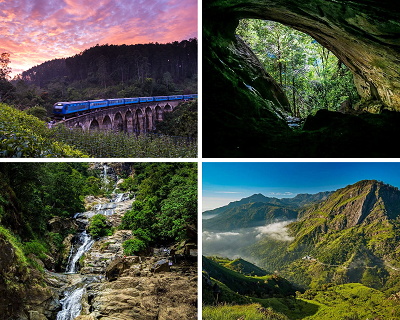
Ravana Cave
Ravana Cave, also known as Ravana Ella Cave, is an intriguing natural site located in Ella. This cave holds great significance in Sri Lankan folklore and is associated with the legendary King Ravana from the Hindu epic Ramayana.
According to local legends, Ravana Cave is believed to be one of the many places where King Ravana sought refuge during his reign. It is said that Ravana used these caves as hidden chambers to hide and protect Princess Sita, whom he had abducted from India. The cave’s association with this mythical tale adds a touch of mysticism and historical fascination to its allure.
Ravana Cave is nestled amidst lush greenery and surrounded by breathtaking natural landscapes. The cave itself is a large rock formation with a series of interconnected chambers and passages. Exploring the cave allows visitors to imagine the historical and mythological events that unfolded within its rocky confines.
Visiting Ravana Cave provides an opportunity to delve into Sri Lanka’s rich folklore and immerse oneself in the ancient tales of King Ravana. It allows visitors to appreciate the natural beauty of the surroundings while reflecting on the cultural heritage and mythical stories that have shaped the country’s identity.
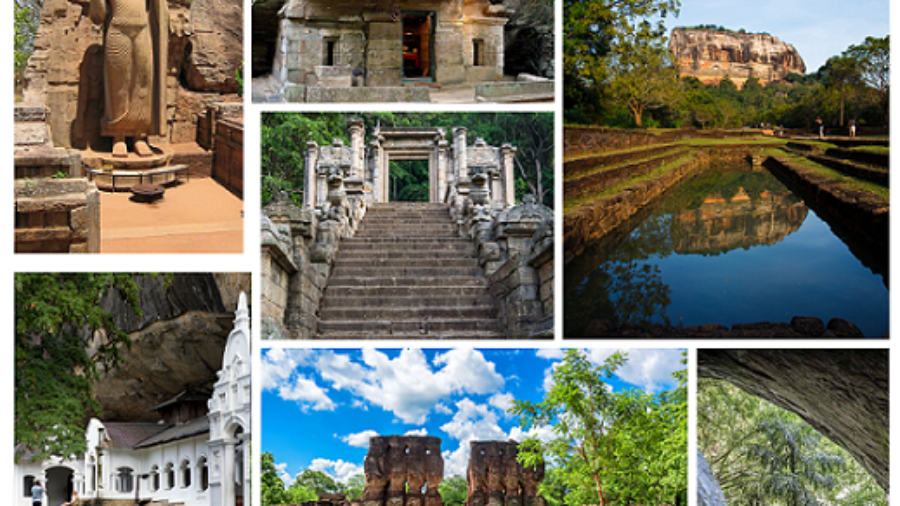
Add a Comment